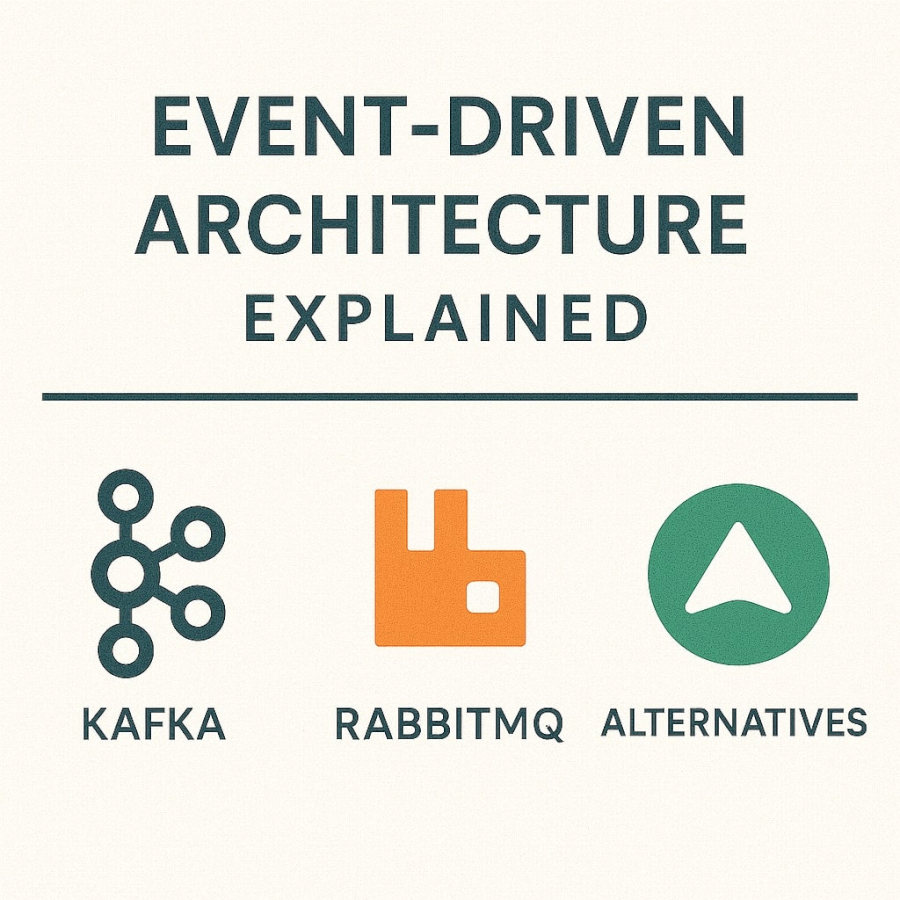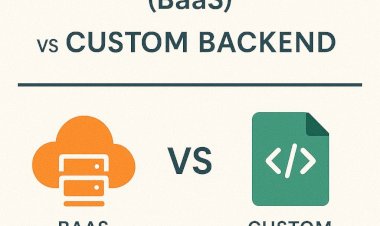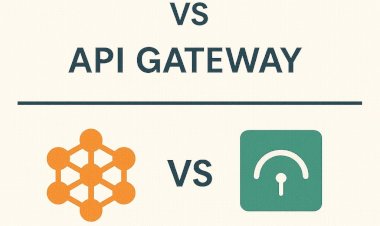Event-Driven Architecture Explained: Kafka, RabbitMQ, and Alternatives
24 May 2025
Event-driven architecture (EDA) has become a cornerstone of modern software development, enabling systems to respond dynamically to changes and events in real-time. As businesses demand more responsive, scalable, and resilient applications, understanding event-driven patterns and the tools that enable them has become essential for architects and developers.
This comprehensive guide explores event-driven architecture fundamentals, compares leading message brokers like Apache Kafka and RabbitMQ, and examines alternative solutions to help you choose the right technology for your specific use case.
Understanding Event-Driven Architecture
Event-driven architecture is a software design pattern where system components communicate through the production, detection, and consumption of events. Unlike traditional request-response patterns, EDA enables loose coupling between services, allowing them to operate independently while maintaining system coherence through event flows.
In an event-driven system, events represent significant changes in state or notable occurrences within the system. These events are captured, stored, and distributed to interested consumers who can react accordingly. This approach enables real-time processing, improved scalability, and enhanced system resilience.
The core components of event-driven architecture include event producers (publishers), event routers (message brokers), and event consumers (subscribers). Event producers generate events when specific conditions are met, event routers ensure reliable delivery to appropriate consumers, and event consumers process events to trigger business logic or update system state.
Key Benefits of Event-Driven Architecture
Loose Coupling and Independence
Event-driven systems promote loose coupling between components, allowing services to evolve independently without affecting other parts of the system. Producers don't need to know about consumers, and consumers can be added or removed without impacting producers, enabling greater flexibility and maintainability.
Scalability and Performance
EDA enables horizontal scaling by allowing multiple instances of event consumers to process events in parallel. This distributed processing capability helps systems handle increasing loads more effectively than traditional monolithic architectures.
Real-Time Responsiveness
Event-driven systems can respond to changes immediately as they occur, enabling real-time analytics, instant notifications, and immediate system reactions to business events. This responsiveness is crucial for applications requiring low latency and high user engagement.
Resilience and Fault Tolerance
By decoupling system components and implementing proper event persistence and replay mechanisms, event-driven architectures can continue operating even when individual components fail. Events can be replayed to recover from failures or rebuild system state.
Apache Kafka: The Distributed Streaming Platform
Apache Kafka has emerged as the leading platform for building real-time streaming data pipelines and applications. Originally developed by LinkedIn, Kafka provides high-throughput, low-latency message processing capabilities that make it ideal for large-scale event-driven systems.
Kafka Architecture and Core Concepts
Kafka organizes data into topics, which are partitioned and replicated across multiple brokers for scalability and fault tolerance. Producers publish messages to topics, while consumers subscribe to topics and process messages in real-time or batch mode.
The partition-based architecture enables parallel processing and horizontal scaling. Each partition maintains an ordered sequence of messages, and consumers can process different partitions simultaneously, maximizing throughput and enabling efficient scaling.
Kafka's commit log design ensures durability and enables message replay. All messages are written to disk and retained for a configurable period, allowing consumers to replay events from any point in the log. This capability is essential for event sourcing patterns and system recovery scenarios.
Kafka Use Cases and Strengths
Kafka excels in scenarios requiring high throughput, low latency, and message durability. Common use cases include real-time analytics, log aggregation, event sourcing, and stream processing applications. Major companies like Netflix, Uber, and Airbnb rely on Kafka for their critical data infrastructure.
The platform's strength lies in its ability to handle millions of messages per second while maintaining low latency. Kafka's distributed nature and replication mechanisms provide excellent fault tolerance, making it suitable for mission-critical applications where data loss is unacceptable.
Kafka Connect provides pre-built connectors for integrating with databases, cloud services, and other systems, simplifying data pipeline construction. Kafka Streams enables stream processing directly within Kafka, eliminating the need for separate stream processing frameworks in many scenarios.
Kafka Limitations and Considerations
Despite its strengths, Kafka has certain limitations that should be considered. The learning curve can be steep, requiring significant expertise to properly configure, tune, and operate Kafka clusters. Operational complexity increases with cluster size and throughput requirements.
Kafka's design optimizes for throughput over individual message latency, making it less suitable for scenarios requiring immediate message delivery guarantees. The platform also requires careful capacity planning and monitoring to maintain optimal performance.
RabbitMQ: The Reliable Message Broker
RabbitMQ stands as one of the most popular traditional message brokers, implementing the Advanced Message Queuing Protocol (AMQP) and providing robust messaging capabilities for event-driven applications. Its focus on reliability, flexible routing, and ease of use makes it an excellent choice for many enterprise scenarios.
RabbitMQ Architecture and Features
RabbitMQ uses a broker-centric architecture where messages are routed through exchanges to queues based on routing rules. This design provides fine-grained control over message routing and delivery patterns, supporting various messaging scenarios from simple point-to-point communication to complex routing topologies.
The platform supports multiple messaging patterns including publish-subscribe, request-response, and work queues. Message acknowledgments ensure reliable delivery, while dead letter exchanges handle messages that cannot be processed successfully.
RabbitMQ's clustering capabilities enable high availability and horizontal scaling. Federation and shovel plugins allow connecting multiple RabbitMQ instances across different data centers or cloud regions, providing geographic distribution and disaster recovery capabilities.
RabbitMQ Strengths and Use Cases
RabbitMQ excels in scenarios requiring reliable message delivery, complex routing logic, and strong consistency guarantees. It's particularly well-suited for traditional enterprise messaging, workflow orchestration, and applications where message ordering and transactional guarantees are critical.
The platform's mature ecosystem includes comprehensive monitoring tools, management interfaces, and extensive documentation. RabbitMQ's support for multiple protocols (AMQP, MQTT, STOMP) makes it versatile for integrating diverse systems and IoT applications.
RabbitMQ provides excellent support for message prioritization, delayed messaging, and complex routing scenarios. These features make it ideal for applications requiring sophisticated message handling logic beyond simple publish-subscribe patterns.
RabbitMQ Limitations
RabbitMQ's broker-centric architecture can become a bottleneck at very high throughput levels compared to distributed systems like Kafka. The platform requires careful queue management and monitoring to prevent message accumulation and broker overload.
Memory usage can be a concern with RabbitMQ, especially when handling large numbers of queues or messages. Persistent messaging impacts performance, requiring trade-offs between durability and throughput based on application requirements.
Comparing Kafka and RabbitMQ
Performance and Throughput
Kafka significantly outperforms RabbitMQ in high-throughput scenarios, capable of handling millions of messages per second compared to RabbitMQ's thousands of messages per second. Kafka's distributed architecture and efficient storage design enable superior scaling characteristics.
However, RabbitMQ provides lower latency for individual messages in many scenarios, making it better suited for applications requiring immediate message delivery. The choice depends on whether your application prioritizes overall throughput or individual message latency.
Durability and Reliability
Both platforms provide strong durability guarantees, but through different mechanisms. Kafka's commit log design ensures all messages are written to disk and replicated across multiple brokers. RabbitMQ uses persistent queues and acknowledgments to guarantee message delivery.
Kafka's design makes it more suitable for event sourcing and audit logging where complete message history must be maintained. RabbitMQ's acknowledgment system provides stronger guarantees about individual message processing completion.
Operational Complexity
RabbitMQ generally requires less operational expertise to deploy and maintain, with simpler configuration and more straightforward scaling patterns. Kafka's distributed nature increases operational complexity but provides better scalability and fault tolerance at scale.
Kafka requires careful tuning of numerous configuration parameters and deep understanding of distributed systems concepts. RabbitMQ's centralized broker model is easier to understand and troubleshoot for many development teams.
Alternative Event-Driven Solutions
Amazon EventBridge
Amazon EventBridge provides a serverless event bus service that connects applications using events from AWS services, SaaS applications, and custom applications. It offers built-in schema discovery, event filtering, and transformation capabilities without requiring infrastructure management.
EventBridge excels in cloud-native applications and serverless architectures where managed services are preferred over self-hosted solutions. Integration with AWS services is seamless, and the pay-per-use pricing model makes it cost-effective for variable workloads.
Apache Pulsar
Apache Pulsar combines messaging and streaming capabilities in a unified platform, offering features similar to both Kafka and traditional message queues. Its multi-tenant architecture and built-in geo-replication make it attractive for large-scale deployments.
Pulsar's unique architecture separates serving and storage layers, enabling independent scaling and better resource utilization. The platform supports both queuing and streaming semantics, providing flexibility for different use cases within the same system.
Redis Streams
Redis Streams adds event streaming capabilities to the popular Redis data store, providing a lightweight solution for event-driven applications. It offers consumer groups, message acknowledgments, and persistence while maintaining Redis's simplicity and performance characteristics.
Redis Streams is ideal for applications already using Redis or those requiring simple event streaming without the complexity of full-featured message brokers. The in-memory nature provides excellent performance for scenarios where persistence requirements are less stringent.
Google Cloud Pub/Sub
Google Cloud Pub/Sub delivers managed messaging service that automatically scales to handle any message volume. It provides exactly-once delivery semantics, global availability, and seamless integration with other Google Cloud services.
The service excels in cloud-native applications requiring global scale and availability. Built-in dead letter topics, message filtering, and schema validation simplify application development while maintaining enterprise-grade reliability.
Azure Service Bus
Microsoft Azure Service Bus offers enterprise messaging capabilities with support for queues, topics, and subscriptions. It provides features like duplicate detection, message sessions, and scheduled delivery that are valuable for complex enterprise scenarios.
Service Bus integrates well with Microsoft's ecosystem and provides strong consistency guarantees suitable for financial and enterprise applications. Support for both brokered and relay messaging patterns adds flexibility for different architectural needs.
Choosing the Right Solution
High-Throughput Streaming Applications
For applications requiring processing of millions of events per second, Apache Kafka is typically the best choice. Its distributed architecture, efficient storage design, and ecosystem of stream processing tools make it ideal for big data and real-time analytics scenarios.
Consider Kafka when building data pipelines, real-time analytics platforms, or event sourcing systems where complete event history must be maintained. The platform's durability and replay capabilities are essential for these use cases.
Traditional Enterprise Messaging
RabbitMQ excels in traditional enterprise messaging scenarios requiring reliable delivery, complex routing, and strong consistency guarantees. Choose RabbitMQ for workflow orchestration, task queues, and applications where message ordering and transactional guarantees are critical.
The platform's mature ecosystem, comprehensive management tools, and support for multiple protocols make it ideal for integrating diverse enterprise systems and maintaining complex message routing topologies.
Cloud-Native and Serverless Applications
For cloud-native applications, consider managed services like Amazon EventBridge, Google Cloud Pub/Sub, or Azure Service Bus. These services eliminate operational overhead while providing enterprise-grade reliability and automatic scaling.
Managed services are particularly valuable for startups and organizations lacking dedicated infrastructure teams. The pay-per-use pricing models can also be more cost-effective for variable or unpredictable workloads.
Lightweight Event Streaming
Redis Streams provides an excellent middle ground for applications requiring event streaming capabilities without the complexity of full-featured message brokers. It's ideal for scenarios where Redis is already in use or when simple event streaming is sufficient.
Consider Redis Streams for session management, real-time notifications, or activity feeds where the simplicity and performance of Redis align with application requirements.
Implementation Best Practices
Event Design and Schema Management
Design events to be self-contained and include all necessary information for consumers to process them independently. Avoid coupling events too tightly to specific consumers by including generic, business-meaningful data rather than consumer-specific details.
Implement schema evolution strategies to handle changes in event structure over time. Use schema registries where available to enforce compatibility and enable safe evolution of event formats across system versions.
Error Handling and Dead Letter Patterns
Implement comprehensive error handling strategies including retry mechanisms, dead letter queues, and circuit breakers. Plan for scenarios where consumers cannot process events and ensure these failures don't impact system stability.
Consider implementing compensating actions for events that cannot be processed successfully. This pattern is particularly important in distributed systems where rolling back complex transactions isn't feasible.
Monitoring and Observability
Implement comprehensive monitoring covering event production rates, consumer lag, error rates, and system health metrics. Use distributed tracing to track events across multiple services and identify performance bottlenecks.
Set up alerting for critical metrics like consumer lag, error rates, and broker availability. Proactive monitoring helps identify issues before they impact system functionality or user experience.
Security and Access Control
Implement authentication and authorization for event producers and consumers. Use encryption for sensitive data in events and secure communication channels between system components.
Consider implementing event auditing and compliance features for regulated industries. Maintain detailed logs of who produced and consumed events for security and compliance purposes.
Future Trends in Event-Driven Architecture
Serverless Event Processing
The trend toward serverless computing is driving demand for event-driven architectures that can automatically scale based on event volume. Functions-as-a-Service platforms are increasingly being used as event consumers, enabling pay-per-use pricing models and automatic scaling.
This trend is making event-driven architectures more accessible to smaller organizations and reducing the operational overhead of managing event processing infrastructure.
Event Mesh and Distributed Event Networks
Event mesh architectures are emerging to connect event-driven applications across multiple environments, including on-premises, cloud, and edge deployments. These architectures enable event-driven communication across organizational boundaries and geographic regions.
The concept extends beyond traditional message brokers to create networks of interconnected event routers that can intelligently route events based on content, location, and other criteria.
AI and Machine Learning Integration
Machine learning is being integrated into event-driven systems for real-time analytics, anomaly detection, and predictive processing. Events provide the real-time data streams needed to train and operate machine learning models in production environments.
This integration enables intelligent event routing, automated response to anomalies, and predictive scaling based on event patterns and historical data.
Conclusion
Event-driven architecture represents a fundamental shift toward more responsive, scalable, and resilient software systems. The choice between Apache Kafka, RabbitMQ, and alternative solutions depends on specific requirements including throughput needs, operational complexity tolerance, and existing infrastructure constraints.
Kafka excels in high-throughput streaming scenarios and big data applications, while RabbitMQ provides excellent reliability and flexibility for traditional enterprise messaging. Cloud-managed services offer operational simplicity at the cost of some control and customization capabilities.
Success with event-driven architecture requires careful consideration of event design, error handling, monitoring, and security aspects. As the technology continues to evolve, new patterns and solutions will emerge, but the fundamental principles of loose coupling, scalability, and real-time responsiveness will remain central to modern software architecture.
The investment in understanding and implementing event-driven patterns will pay dividends as systems grow in complexity and requirements for real-time processing continue to increase across industries and applications.

